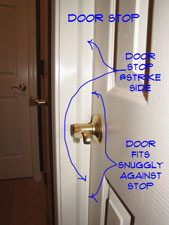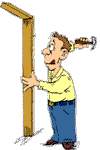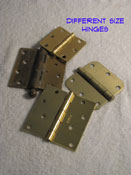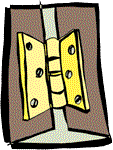Doors
Adjusting the Door Stop
 The door stop is the raised piece of trim in the center of the jamb. It is on the top and both sides of the door. Sometimes and this is not common, the stop will need to be adjuste to get the door to close properly.
The door stop is the raised piece of trim in the center of the jamb. It is on the top and both sides of the door. Sometimes and this is not common, the stop will need to be adjuste to get the door to close properly.
Not sure if this is your problem? See the articles, 'How To Fix a Door Frame' and 'Troubleshooting Door Problems' for more information and a listing of all the door topics.
As the name implies it acts as a stop for the door, not allowing it to swing through the opening and tear out the hinges. It also conceals the gap around the door, thus keeping the privacy feature of the door intact. The door stop can loosen up or it can be damaged.
Adjusting Door Stop
For door stop that is loosened and not aligned properly you can adjust it and nail it in place.To loosen the door stop, use a flat pry bar.
Close the door and push the stop against the door gently. You want the stop to touch the door, but not push it back. Use a pencil to mark the proper locations of the stop. A #4 or #6 finish nail is usually sufficient for door stop.
I am assuming that you do not have an air driven finish nail gun. Use a hammer and nail set to nail the stop back in place. Nail it every 12 inches or as needed. Touch up the paint or varnish and you're done. This was not such a difficult door frame repair.
Replacing Door Stop
Replacing damaged door stop is similar but a bit more involved. Use a flat pry bar to gently loosen the stop. It is best to replace the entire piece, either the side or top. Take a piece with you to the lumber yard and find one that matches. They usually sell 7' sections which is enough for one side of the door.
You will need to use a miter box either hand or power to cut the piece to fit. When you have the piece cut to the right size you can install it.
Mark the location as described above and nail it in place with finish nails. You may have been fortunate and found a pre-finished piece that matches what you have. Likely case is that you will have to paint or stain it to match the existing. Done with this door frame repair? Good, move on to your next project.
You should review the related articles, 'Adjusting Interior Doors' and 'Adjusting Exterior Doors' to make sure you have covered all the door adjustment topics.
How To Fix a Door Frame
 Knowing how to fix a door frame can save you time and money. Door repairs can be expensive and time consuming. Door frames that are installed properly in the beginning, rarely fail to perform unless somthing has damaged them.
Knowing how to fix a door frame can save you time and money. Door repairs can be expensive and time consuming. Door frames that are installed properly in the beginning, rarely fail to perform unless somthing has damaged them.
When a door does not close properly, it is usually something else that is causing the problem. See the articles 'Adjusting Interior Doors', 'How To Adjust Exterior Doors', 'Fixing Door Locks' and 'Repairing Door Hinges' for more information and instructions on what to do.
If you are sure that it is the door frame that needs to be repaired, see the 'Troubleshooting' section below.
How a Door Frame Works
Door frames provide the needed support for a door. Some doors can weigh hundreds of pounds. The door is attached to the frame via the hinges. When properly installed, door frames are durable and will last a long time.
Problems with the door frame are often related to the things that are attached to it. Hardware, weatherstripping, strike plates and the door itself are attached to the frame.
Fixing the frame may mean adjusting or replacing one of these items. Other times it can involve work on the frame itself.
Door Frame Repair - The Issues
What Can You Save? - Doing a major overhaul on a door frame could easily be a four hour job. If you just need something adjusted it could cost as little as $50. A complete re-work of the frame could be between $150 and $300.
How Hard Could It Be? - Door frame repairs can vary in difficulty and complexity. These repairs will have a Difficulty Range of: Simple to This Is Clearly Work. These repairs require a Skill Level Range of: Job Jar Specialist to Determined Handyman. For and explanation of the terms in this section, see 'How to Use This Site'.
Check the Simple Things! - The frame is the part of the doorway that provides the structural support. A problem with the door frame is usually not a simple problem. Adjusting the strike plate or replacing the hinges are probably the simplest things that you can do with a door frame.
What Can Go Wrong? - Taking apart the door frame can be a big job and may take longer than a couple of hours. You may not get the door back together. You could be without a door if you can't get it fixed. Which door it is? This will determine the severity of the situation. Make sure you have the basic skills needed before you attempt to dismantle a door.
Door Frame Repair – The Steps Involved
Most of the time getting the door properly adjusted will take care of issues related to the frame. See the articles 'Adjusting Interior Doors' and 'How To Adjust Exterior Doors' for information on getting the doors properly aligned.
When the door is adjusted properly and the lock still won't work or the door is not tight to the weatherstripping, you may need to adjust the strike. 'Adjusting Door Strikes' gives you information on this subject.
The hinges are one of the key pieces of hardware that are attached to the door frame. 'Replacing Door Hinges' talks about replacing and lubricating them.
At times, the door stop can loosen, causing the door not to close correctly. The article 'Adjusting the Door Stop' explains how you can fix it.
'Repairing a Split Door Frame' is a discussion on fixing a broken frame.
Summary
Door frame repairs are harder than other door repairs. If you take your time and are willing to develop new skills then you were successful with this repair. Remember it is the door frame that holds up the door. Should it be easy?
Tales will be told long into the future of how you were able to make your own door frame repair. Repairing a door jamb will not be something you need to do often. Usually, once the are set they don't go anywhere. The work you did should last for years.
Door Hinge Sizes
 Door hinge sizes are an issue when purchasing new hinges. You will only want to do this if they need replacing.
Door hinge sizes are an issue when purchasing new hinges. You will only want to do this if they need replacing.
It is more likely that your door is out of adjustment, see 'Adjusting Interior Doors' or 'Adjusting Exterior Doors' for more information.
See 'Door Repair' for a complete listing of door topics.
The size and weight of the door will determine the size and number of hinges. Usually, you will replace the old ones with the same size and quantity.
A valid question. Most residential doors are between an 1 3/8" and 1 3/4" thick. So the normal size hinges for a residential door are 3" x 3" or 3 1/2" x 3 1/2". Your entrance doors might have 4" x 4" hinges, since the doors are heavier and usually thicker than the interior ones.
Measuring Door Hinge Sizes – You measure a door hinge when it is open and lying flat. The height is one dimension and the distance across both leaves is the other dimension. Butt door hinges are often the same size each way, but they don't have to be. It is possible to have hinges that are taller than they are wide. So it is a good idea to measure them both ways.
Is the hinge still on the door? Then you will have trouble getting a good measurement. You can also measure one side of the hinge from the edge of the hinge to the center of the pin. Take this dimension and double it to get the correct size.
Checking the Corners – There are more options, with different types of hinges, when it comes to the corners on the hinge. They might be square or they could have a radius. The square ones are easy, they are square. Both square and round corners are available with different door hinge sizes.
Radius corners are a more of a problem. They can be different radius's. The two common sizes for a radius on a door hinge is either 1/4" or 5/8". You should be able to use a tape measure to determine which size you have.
You may be wondering about the corners, why the difference? Rounded corners are made to fit into mortises that are cut with a router. Hinge jigs and commercial mortising machine use a round cutting head to cut out the mortise. So round corners are easier. They do have machinery that will cut square corners, but it involves another step.
Square corners are better when you are cutting the mortises with a chisel. Round corners are hard to do with a chisel. So there you have it, depending on the tooling you have, you may prefer, square or round corners. When replacing hinges, it makes things much easier to get the same size and style of hinge. Then you don't have to mess with the mortises at all.
So you have two things with the size that you need to make a note of. First the size of the hinges, height x width. Next the type and size of the corners on the hinge. When shopping for different types of hinges the best thing to do is take one of the old ones with you. Match them up at the store and you can't go wrong.
Purchasing Door Hinges
For a door hinge installation or replacement, you want hinges that are the same size and type as the one you have. The best practice is to take an old hinge with you when looking for replacements.
Even among hinges that are the same size, styles can vary. Spring loaded and ball bearing hinges are a couple of examples. See the article 'Types of Door Hinges', for an explanation of the various types and sizes of hinges.
Color and metal type are also important. A door with brass hardware, will likely have brass hinges. You may find stainless steel hinges that are the right size. It would be best to keep looking until you find the right metal finish.
Door hinges are measured by the dimensions when the hinge is open and lying flat. A 3 1/2" x 3 1/2" hinge will be 3 1/2" high, have a center pin and two plates that are approximately 1 1/2" wide. The common sizes for door residential door hinges are 3" and 3 1/2". They can come with both square and rounded corners. Most hardware stores and home supply stores will have a selection and stock the common sizes.
WARNING!! Doors Are Heavy, GET HELP When Removing a Door. Chisels Are Sharp, Use Caution!!! WARNING!!!
Summary
As you can see door hinges come in a number of sizes. See the articles, 'Adjusting Door Hinges', 'Replacing Door Hinges' and 'Squeaky Door Hinges' for related information.
Residential Door Hinge Types
 Are you looking for different types of hinges for doors? There are different kinds and sizes.
Are you looking for different types of hinges for doors? There are different kinds and sizes.
For related information see the articles, 'Door Hinge Repair' and 'Troubleshooting Door Problems'.
A hinge is a hinge, right? Well not exactly, hinges are similar, but they differ in type and size. Do you know what type of door hinge that you need? This article will help you determine what type you need and how you can go about finding them.
Most door hinges are classified as 'butt hinges', that makes is simple, right? Well, sort of. Butt hinges describe the two entities that are 'abutted' together. The door and the frame are examples. The term 'Butt Hinge' is somewhat broad and can describe multiple types. For residential hinges, you do not have that many types. Whew! Did you think we were getting into a tough subject?
It is a little tough, when you factor in the size and style issues. There are several sizes that you can encounter. In addition, each size can have different styles. Don't despair, most styles and sizes are fairly common and you should be able to figure it out.
Types of Hinges for Doors - Information
This article on different types of hinges is a resource. It is intended to provide basic information. We do not classify this information as a repair. Therefore, the Common Sense evaluation is not included. Instead we provide you with facts about types and sizes of hinges that you will need to use.
Different types of hinges for doors are often sold in pairs. However, you will find some online stores that quote a 'per hinge' price. Be careful when ordering on line. The price doubles or triples when you get enough to do a single door.
Door Hinge Styles
There are several door hinge styles to choose from. They 'style' of hinges on your existing doors will likely play a major role in your decision.
Concerned with the size of the hinge? See 'Door Hinge Sizes' for more information. Related articles are 'Door Hinge Repair' and 'Door Hinge Installation'.
Butt Hinges – The standard term used for door hinges. It has nothing to do with the hinge itself. Instead, it refers to the fact the two surfaces are 'abutting'. In the case of a door it would be the door and the frame.
Loose Pin – This is a standard feature for most residential hinges. The pin can be removed for easy removal of the door. The pin is driven out from the bottom.
Fixed Pin – Less common for residential doors. You may find this type on older doors. The entire hinge needs to be removed to take the door down. Ball bearing hinges are often fixed pin hinges.
Ball Bearing – Ball bearing hinges provide smoother operation for the hinge. Instead of metal rubbing on metal, the ball bearings provide the surface to move on. These hinges cost more and are not generally found in residential installations.
Spring Loaded – This style of hinge has a spring built into to force the door closed. Garage man doors and screen doors are examples of doors that you want to shut automatically. The spring loaded hinges are rated for a certain amount of weight. You may need as many as three on a heavy door. Lighter doors only require one.
Ball or Finial Tip – This is a variation of a loose or fixed pin butt hinge. There is a decorative ball or finial on the top and bottom of the pin.
Door Hinge Finishes
There are many types of door hinge finishes. Add to the that different naming conventions. What is the difference between 'Bright Brass' and 'Polished Brass'? Then there are the restoration hardware finishes and the list goes on and on.
One thing to take note of is the quality of the hinges. Some finishes are only a surface coating over a steel base. These thin coatings will disintegrate over time, sometime flaking off. The result is a hinge that looks bad, even though it may still be functional. The 'you pay for what you get' applies to the finish.
- Brass – This is probably the most common type you will find. Brass does not rust making it a good choice for hinges. Brass does discolor and tends to start looking bad over time. Cheaper hinges may only have a brass coating.
Available Brass Finishes: Bright or Polished, Antique, Brushed or Satin
- Bronze – Similar to brass these hinges do not rust. These types of door hinge finishes can stain and discolor over time making a functional hinge look bad. Cheaper hinges may only have a coating on them over steel.
Available Bronze Finishes: Oil Rubbed or Antique, Smooth or Lacquered, Brushed or Satin
- Nickel – A popular finish for hinges. It is durable and usually comes in a satin or brushed finish. It looks similar to stainless steel and good quality hinges of this type will not rust.
Available Nickel Finishes: Brushed or Satin, Smooth
- Stainless Steel – Good quality stainless steel hinges will not rust or discolor. These hinges tend to be more expensive and are found less often. They are more common in commercial installations.
Available Stainless Steel Finishes: Brushed or Satin, Smooth
- Chrome– Looking for a mirror like finish? Chrome may be the answer. Chrome door hinge finishes are applied over another type of metal. Quality is an issue. Poor quality chrome hinges have a coating that can flake off, making the hinge unattractive.
Available Chrome Finishes: Bright or Polished
- Painted– Hinges can be painted. This is found on older doors or restoration style hardware. Factory painting may stay intact and fit in with a particular decor. There is no limitation to colors that can be used. Paint build up over time can affect the operation of the door and paint can flake off at friction points.
Available Paint Finishes: White or Black, Unlimited Custom Choices
The above list of door hinge finishes is not comprehensive. It gives you the general idea of what is available. When you are replacing different types of hinges the best advice is to take a hinge with you when you shop. Color and quality are best compared with the item in hand.
Summary
Do you feel better able to deal various types of hinges for doors? Replacing hinges on a door is not that hard if you get the right hinges. Corners and size are an issue. Getting a hinge that is a different size will require that you do some carpentry work on the door and frame. Avoid this if you can.
Replacing hinges for appearance issues is also possible. Some hinges work fine, but they look bad. Remember, quality is an issue with hinges. Cheap hinges will not last over time. Hopefully, you are done learning about different types of door hinges and are ready to move onto your next project.
Troubleshooting Closet Doors
Troubleshooting closet doors and fixing the associated problems is common. You probalbly have many closet doors in your home. They may vary in style and size, but they all have one thing in common. Closets are meant for storing things and the doors hide the stored items from view. Closet doors do need attention and quit working correctly periodically. When that happens you need to do some repair work.
Frank Lloyd Wright refused to include closets in the homes he designed. He said that they promoted clutter. Clutter or not, we all have things that we want to store. Thus, closets are very popular. In fact 'lots of closet space' is a selling feature for a home.
Closets and closet doors are a standard feature in homes. The doors differ in size and type. Since they do not get the use that regular door get they tend to be a little less sturdy and can get knocked out of adjustment. Adjusting the doors on closets is often the repair that is needed. Fortunately, it is not that hard to do.
There are three popular styles of closet doors. Each style can have different types of doors, such as mirrors or louvers. A few decades ago most closet doors had sliding doors. Then an innovation came along and the bifold door is the undisputed king of closet doors. Regular swing doors are also used for closets.
Troubleshooting Closet Doors – Finding Help
Below you will find some common problems. There is a brief description and a link that will lead you to additional information. Our evaluation sections of the pages will help you to decide if you want to make the repair. The "What Can You Save?" and "How Hard Could It Be?" sections give you a quick overview of the repair. This will help you decide if it is using good judgment to make the repair yourself.
The "Check the Simple Things First" section will clue you in to easy fixes to check for. Many times something easy will eliminate a problem without the aggravation of an involved repair. In an effort to warn you about what you are in for, there is the "What Can Go Wrong" section. Forewarned is forearmed as they say. Knowing what to watch out for is always helpful.
Repairing Bifold Closet Doors
Bifold doors have become very popular in residential construction. These doors are inexpensive and easy to install, making them a first choice with builders. Adjustment are the main problem. Four panel bifold doors can be a little challenging to adjust. The door has to align in several directions.
Installing Bifold Doors
You may decide that a new bifold door is what you want. Perhaps the old door is tired looking. In addition, you found out that a new one is not that expensive. Can you install the door yourself? Is it hard? Find out what you are up against by following the link above. This is something you can do yourself and save the price of a carpenter.
Mirrored Bifold Closet Doors
Similar to normal bifold doors, these doors have mirror units on the door panels. They serve as a full length mirror in addition to hiding the contents of the closet. They are a little heavier than a normal bifold. The have the same problems as regular bifolds, adjusting being the biggest one.
Troubleshooting Closet Doors - Summary
Troubleshooting and repairing issues with closet doors is a simple task most of the time. It is often just a matter of adjusting the door or replacing some inexpensive parts. A few minutes work and your door will be quiet and smooth.
Now that you have reviewed the information on troubleshooting closet doors, you are ready to research other home repairs. Do you have a list? Or is it a job jar? Whatever your tracking method, you can go to the next item. Unless you have earned a break.

